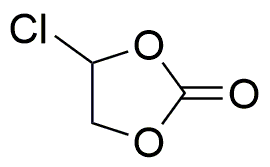4-Chloro-1,3-dioxolan-2-one is widely utilized in research focused on:
- Synthesis of Pharmaceuticals: This compound serves as an intermediate in the synthesis of various pharmaceutical agents, enhancing the efficiency of drug development processes.
- Polymer Chemistry: It is used in the production of biodegradable polymers, contributing to environmentally friendly materials that meet the growing demand for sustainable products.
- Agrochemicals: The compound plays a role in the formulation of agrochemicals, improving the effectiveness of pesticides and herbicides while minimizing environmental impact.
- Analytical Chemistry: It is employed as a reagent in analytical methods, aiding in the detection and quantification of other chemical substances in complex mixtures.
- Material Science: The compound is explored for its potential in the development of advanced materials, including coatings and adhesives that require specific chemical properties for enhanced performance.
General Information
Properties
Safety and Regulations
Applications
4-Chloro-1,3-dioxolan-2-one is widely utilized in research focused on:
- Synthesis of Pharmaceuticals: This compound serves as an intermediate in the synthesis of various pharmaceutical agents, enhancing the efficiency of drug development processes.
- Polymer Chemistry: It is used in the production of biodegradable polymers, contributing to environmentally friendly materials that meet the growing demand for sustainable products.
- Agrochemicals: The compound plays a role in the formulation of agrochemicals, improving the effectiveness of pesticides and herbicides while minimizing environmental impact.
- Analytical Chemistry: It is employed as a reagent in analytical methods, aiding in the detection and quantification of other chemical substances in complex mixtures.
- Material Science: The compound is explored for its potential in the development of advanced materials, including coatings and adhesives that require specific chemical properties for enhanced performance.
Documents
Safety Data Sheets (SDS)
The SDS provides comprehensive safety information on handling, storage, and disposal of the product.
Product Specification (PS)
The PS provides a comprehensive breakdown of the product’s properties, including chemical composition, physical state, purity, and storage requirements. It also details acceptable quality ranges and the product's intended applications.
Certificates of Analysis (COA)
Search for Certificates of Analysis (COA) by entering the products Lot Number. Lot and Batch Numbers can be found on a product’s label following the words ‘Lot’ or ‘Batch’.
Numéro de catalogue
Numéro de lot/série
Certificates Of Origin (COO)
This COO confirms the country where the product was manufactured, and also details the materials and components used in it and whether it is derived from natural, synthetic, or other specific sources. This certificate may be required for customs, trade, and regulatory compliance.
Numéro de catalogue
Numéro de lot/série
Safety Data Sheets (SDS)
The SDS provides comprehensive safety information on handling, storage, and disposal of the product.
DownloadProduct Specification (PS)
The PS provides a comprehensive breakdown of the product’s properties, including chemical composition, physical state, purity, and storage requirements. It also details acceptable quality ranges and the product's intended applications.
DownloadCertificates of Analysis (COA)
Search for Certificates of Analysis (COA) by entering the products Lot Number. Lot and Batch Numbers can be found on a product’s label following the words ‘Lot’ or ‘Batch’.
Numéro de catalogue
Numéro de lot/série
Certificates Of Origin (COO)
This COO confirms the country where the product was manufactured, and also details the materials and components used in it and whether it is derived from natural, synthetic, or other specific sources. This certificate may be required for customs, trade, and regulatory compliance.


